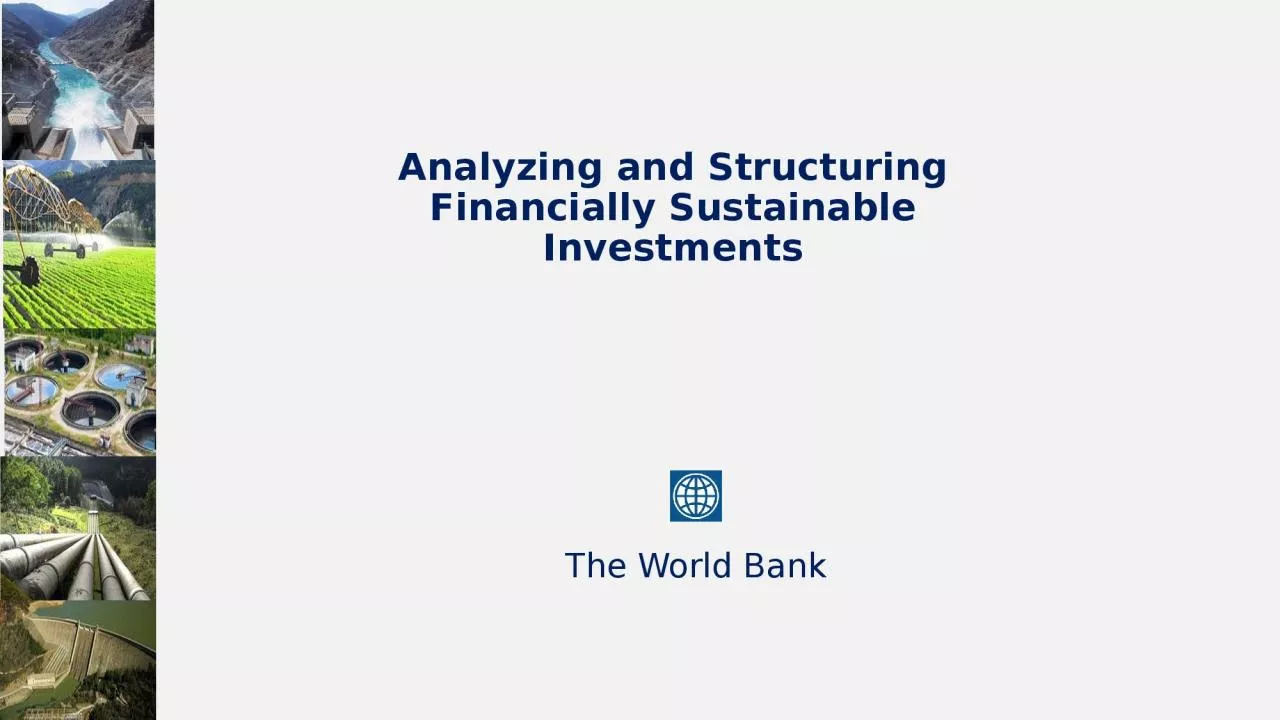

The World Bank Basic Requirements for Financially Sustainable WSS Investments Foundation for a Sustainable Utility Cost Recovery Improved Management Break Through Financing Limits Financial Viability ID: 1021256
Download Presentation The PPT/PDF document "Analyzing and Structuring Financially Su..." is the property of its rightful owner. Permission is granted to download and print the materials on this web site for personal, non-commercial use only, and to display it on your personal computer provided you do not modify the materials and that you retain all copyright notices contained in the materials. By downloading content from our website, you accept the terms of this agreement.
1. Analyzing and Structuring Financially Sustainable InvestmentsThe World Bank
2. Basic Requirements for Financially Sustainable WSS Investments
3. Foundation for a Sustainable UtilityCost RecoveryImproved ManagementBreak ThroughFinancing LimitsFinancial ViabilityExpand Coverage/Service Poor Communities
4. WSS Providers Must Have Sufficient Working Capital to Pay Their Ongoing BillsWorking Capital is measured by the Current Ratio which essentially calculates current assets over current liabilities.At minimum, the Current Ratio should be 1.2. However, a much higher ratio may indicate that short term assets are not used efficiently. A ratio of less than 1.0 may indicate cash flow problems or the inability to convert revenues into cash.
5. Determining the Cash Flow Solution
6. Strategy for Financial SustainabilityImprove sector performance and close revenue gapUse subsidies sparingly and for transitionBring in government as real owners in the financing challenge Make use of all sources of financingUse concessional finance correctly
7. FIRR vs. NPV?The NPV is the value of the sum of projected cash flows discounted at the cost of capital. Any value over zero indicates adequate return, but the higher positive value show a higher return. The NPV calculation Does not give you’re the exact rate of return. Just tells you that you are either above or below your threshold level. The Financial Internal Rate of Return is the rate of return expressed as a percentage that the Project yields. Through extrapolation you can equate the two by either increasing or decreasing the discount rate so that the NPV equals zero. In other words if your NPV is 0 at 15% discount rate then the FIRR should be 15%.However, the FIRR can produce different values of the same cash flow and can produce the wrong number. Moreover, the FIRR formula assumes that the cash surpluses are reinvested at the FIRR rate – which is not necessarily correct. In order to correct this problem the Modified IRR formula was developed which deals separately with the reinvest rate. The formula for NPV and FIRR are exactly the same for the economic analysis. In that case they are usually referred to as the ENPV or the EIRR. The difference is how you calculate the costs and benefits. The financial analysis only includes cost and benefits that accrued to the project, not externalities that accrue outside the project to the wider economy.
8. Which Project is More Financially Sustainable?Year 1Year 2Year 3Year 4Year 5-150406030-50-50-50-50-50250-10020253032ProjectFIRRNo 17.7%No 29.1%No 32.6%WACC10%7%2%Go/No Go
9. Ways to Close the Financial Sustainability GapRevising Capex Program by Allowing PIP to Take EffectReducing CAPEX Program Altogether
10. Ways to Close the Financial Sustainability Gap
11. Shaping the Financing Structure
12. Government Support12
13. How Financing Can be Structured to Address Sustainability Cash Flow Problems Subsidiary Loan Agreement Bank Loan/Credit Agreement to GovernmentFinancially Sustainable Terms to the UtilityLocal currency financingExtended grace and maturity periodsLower cost of fundsGrant allocationTerms to government
14. Government Support Options14
15. Approach of Blended FinanceAttempts to lower the overall cost of capital to an investmentStretch out repayment obligations through long term sources. Hence meet both cash flow and efficiency considerations. Can work with higher leverage structures with enhancements such as performance bonds15
16. Common Transaction PPP StructuresCharacteristics16Straight Private DealLeast Govt. SubsidyViability Gap FinancingODA Hybrid IODA Hybrid IITypical Private Finance with 35-65 capital structure, 15 year, 3 year grace. Private financed deal with up-front government subsidy component.Viability Gap fund made available through ODA replaces upfront grant from Government.ODA can increase debt component . WB has gone up to 85% debt with tenures of as high 30 years and 10 years grace.Can add government grant component to the hybrid I structure.Structure
17. Effects of Blended Finance Structures for PPPs17
18. Effects of Blended Finance on Net Present Value and Cash Flows
19. Improving Cost Recovery
20. Biggest Mistakes Our Clients Make Our Loans Trickling Disbursements and Losing the Benefit of Grace periodsTaking on More Debt than the Utility Can SustainLoans in FX Currencies
21. Thank You